If you’re going to Italy, it’s tempting to hit the biggies: Venice, Florence, Rome. But don’t forget that there’s so much of Europe to see, beyond its marquee cities. To mix things up, seek out some lesser-known towns that are, in their own way, just as satisfying but have a fraction of the crowds.
Finally returning to Europe just a few months ago, in addition to some old favorites (like the Cinque Terre and Siena), I made time for a few new places that most tourists miss. And I must stay, I liked them at least as much as the biggies. These four examples — Modena, Lucca, Treviso, and Trento — all happen to be in the northern part of Italy. But lesser-known gems like these are everywhere…and not just in Italy.
On this trip, I finally made it to Emilia-Romagna, Italy’s most renowned culinary region. Foodies have discovered Emilia-Romagna, but so far it’s largely off the radar of mainstream tourism. Bologna is the capital and leading city, but I stopped off in three smaller towns — Modena, Parma, and Ferrara — that are more accessible while offering a culinary and cultural landscape that’s just as impressive. And my favorite of these was Modena.
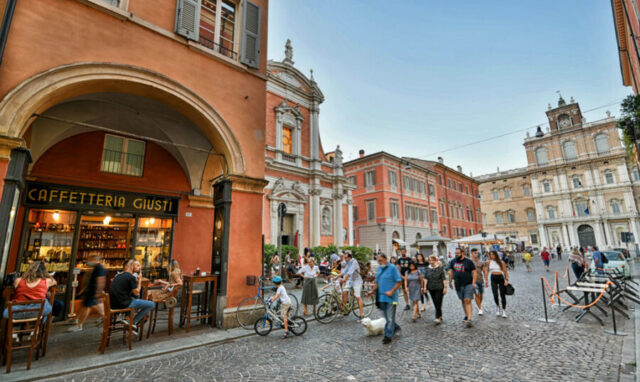
If you’ve heard of Modena, it’s probably because of food. This is the production center for the top-quality balsamic vinegar of Modena (aceto balsamico tradizionale modenese) — a thick, oozing, luxurious, black liquid that explodes on the tongue with decades of barrel-aged flavor. Modena is also the home of the world’s best restaurant, Osteria Francescana, owned and operated by the animated Massimo Bottura. If you’ve watched any “foodie TV” about Emilia-Romagna, you’ve surely seen Massimo mugging for the camera as he shaves delicate curls from gigantic wheels of Parmigiano-Reggiano. (I have no evidence that Massimo is contractually obligated to appear in every single Netflix series relating to food. But I have my suspicions.)
It was the food that brought my wife and me to Modena. We couldn’t get a table at Osteria Francescana — and anyway, we weren’t up for the €500-per-plate price tag. But we did reserve at Massimo’s casual bistro, Franceschetta 58, which offered a sampling of that world-renowned fare for one-tenth of the price. While the five courses were a bit hit-or-miss, the highlights — including delicate, handmade tortellini in a Parmigiano-Reggiano fondue sauce — were astonishingly good.
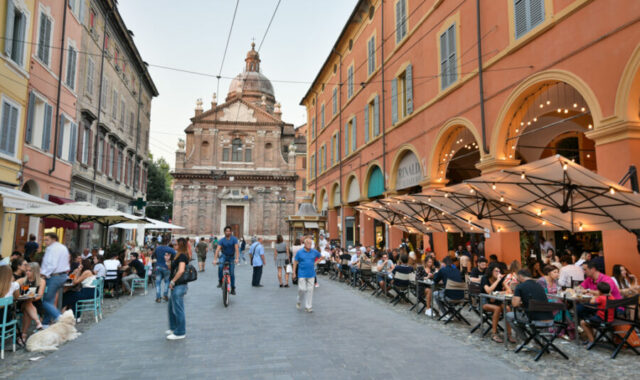
In fact, every meal we had in Emilia-Romagna was sensational. Italy has great food, but in its über-touristy towns, I find that I miss just as often as I hit. (Frankly, I can’t remember a single truly great meal I’ve had in Florence or Venice.) But in the untouristy towns, restaurants cater to locals rather than visitors, which gives them incentive to turn out excellent food at reasonable prices.
I was in Modena for a Sunday night, when virtually every trattoria and osteria in town was closed. After checking five or six, I landed on my “last resort” — the only place I could find that was actually open: Trattoria da Omer. I set my expectations low, simply relieved to find an alternative to a meager picnic dinner in my Airbnb. But it turned out to be far from an act of desperation; it was one my favorite meals of the trip. The owner brought out a big chalkboard menu, then proceeded to ignore it as he personally talked me through the options to craft my ultimate dinner. Strange as it sounds, it was at least as good as Massimo’s place.

But Modena is more than food; that’s just a trojan horse for attracting travelers to one of Italy’s finest and most livable small cities. The streets feel manicured; the mismatched riverstone cobbles gleam in the hot sun. Arcades are populated by intriguing shops and delightful cafés. And the big, beautiful main square is a classic Italian piazza, with a church bell tower facing down a city hall tower over al fresco café tables. Later, an Italy aficionado told me that the church interior is also impressive. I wouldn’t know, because I didn’t bother to go inside; I was too busy enjoying the simple act of wandering around.
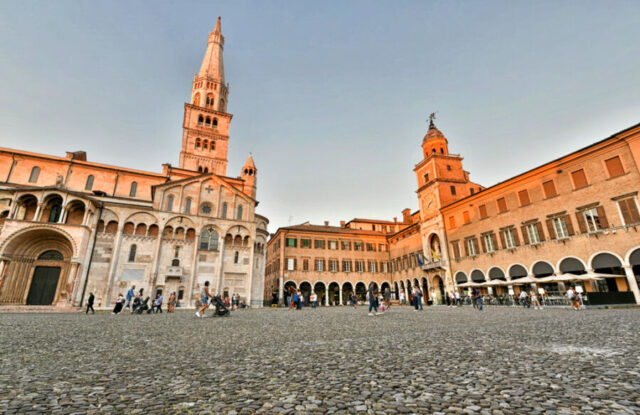
By the way, one thing I notice about these “untouristy” towns is that they’re full of bicycles. Locals commute on streets and alleys, right through the center of town. From a “leaping out of the way of an oncoming bike” perspective, Modena felt like Amsterdam or Copenhagen. I don’t see this in the more touristy Italian cities — I imagine because their infrastructure is oriented more toward visitors than commuting locals.
In untouristy towns like Modena, another thing you notice is the near-total lack of souvenir stands. Instead of spinning racks of postcards and tacky T-shirts and shot glasses, you see pharmacies, fashion boutiques, midrange chain stores, hole-in-the-wall alimentari, and kitchen-supply shops. In short, places where locals do their shopping. While touristy towns have restaurants with exclusively Italian menus, the untouristy ones have a wider variety: Hawaiian-style poke is all the rage, and I spotted several sushi restaurants in Trento, of all places. I also noticed far more people of color in Modena (and other cities of Emilia-Romagna) than in Italy’s tourist hotspots, dispelling the misconception that Europe is an entirely white continent.
In Tuscany, my wife and I stopped off for lunch in Lucca — which has long been one of my favorite Tuscan towns. I liked it even more this time around. It feels approximately the same size, bustle, and quaintness of Siena, where we’d had lunch the previous day. And, while not exactly “undiscovered,” it was noticeably (and enjoyably) less crowded than Siena.

This got me thinking about why places become popular, or don’t. Lucca is perfectly placed to not become a tourist town, while still remaining convenient for tourists — an improbable feat. Lucca sits in the northwest corner of Tuscany, rather than along the central Florence-Siena-Rome corridor. There is one place people venture out here to visit, and it’s just a half-hour from Lucca: Pisa. The Field of Miracles is stunning and worth seeing. But its popularity has transformed Pisa (or, at least, that little corner of Pisa) into one of Italy’s crassest and most grotesque tourist traps.
And yet, there sits Lucca. In the time it takes me to drive from my house to my office each morning, you can go from the Leaning Tower to uncrowded Lucca. Far from being “overshadowed” by Pisa, this works to Lucca’s advantage, for those of us who enjoy less touristy towns. If you’re enjoying a picnic and ants or bees are driving you crazy, you set out a little dish of sugar water to distract them while you happily munch away on your food. Pisa is the sugar water; Lucca is the main course.
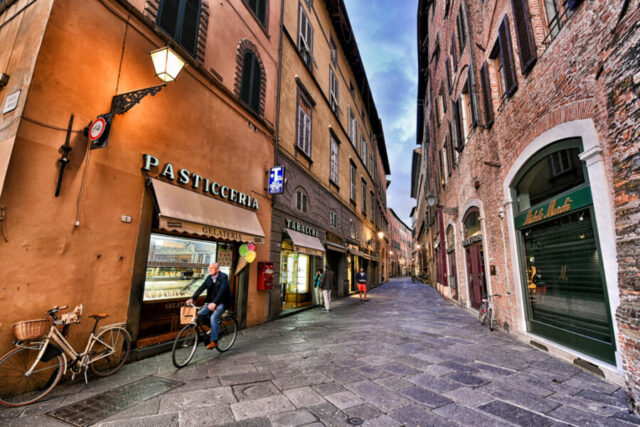
Farther north, I spent a couple of nights in Treviso, which is as close to Venice as Lucca is to Pisa. But I didn’t go to Pisa on this trip, and I didn’t go to Venice, either. Instead, I enjoyed simply exploring Treviso, which I had entirely to myself. The only other American tourist I spotted was a gentleman from Atlanta who lives part-time near Lake Como and, like me, is an aficionado of untouristy Italy.
Why did I go to Treviso? I asked myself that several times before I arrived, and the answer was entirely practical: Because it was the only place between Milan and Croatia that had a direct flight to Prague, where I was heading next. (Plus, I’d read an intriguing New York Times article about Treviso a couple of years ago, which makes many of the same points I’m making here.)
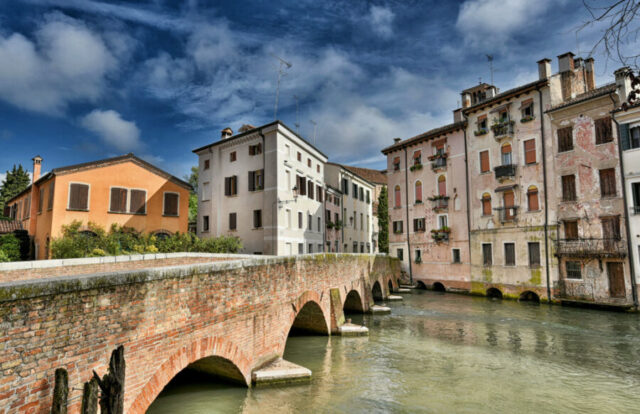
Treviso is unspectacular, yet it’s delightful. People moon over Treviso’s canals, but that’s an overstatement — motivated, I believe, by a sort of inferiority complex relative to Venice. Treviso’s canals are pretty, but there aren’t that many of them, and anyway, I’ve been to plenty of cities with canals that still manage to be miserable. The Chicago stockyards have canals.
Don’t go to Treviso for the canals; go because it’s simply a pleasant, beautiful, untouristy town. Maybe it’s because I was in Treviso to wander, rather than to work, but I never even began to get a handle on the curling snarl of streets that make up its historical core. It’s small enough that you can enjoy getting lost without getting nervous. Mainly I enjoyed sitting at the café tables that fill the enormous loggia on the main square. (In fact, I sat there as I wrote this blog post.)
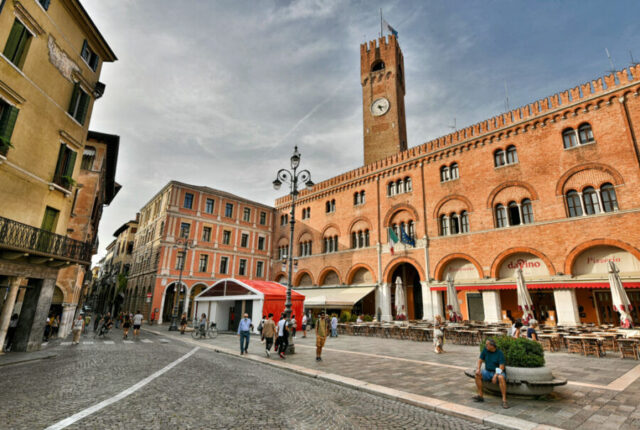
One thing I love about these untouristy towns is that each one has its quirky claims to fame, which it’s extremely proud of. Treviso is, reputedly, the birthplace of tiramisù and of Benetton. I enjoyed one of the former during my time here and, not coincidentally, have put on enough pandemic weight not to be too interested in the latter at the moment.
Speaking of which, I had several great meals in Treviso — again, far more than I can remember having in Venice, where I’ve spent many times as many days. After doing just a little homework, I found that I simply couldn’t miss — each meal was a masterpiece, and very affordable.
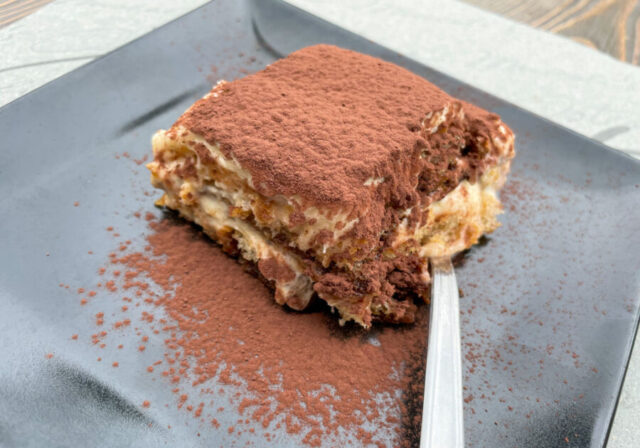
Would I go out of my way to visit Treviso? Probably not. But my goal was simply to melt into Italy for a couple of days. And for that purpose, Treviso was ideal. Some suggest staying in Treviso and day-tripping to Venice — just 30 minutes by train. While that would be a great strategy for the right traveler, this traveler didn’t bother going into Venice, and didn’t miss it one bit.
I also enjoyed stopping off for a lunch in Trento, on my way between Emilia-Romagna and Castelrotto, in Italy’s Dolomites. Trento is the capital of Trentino, a region that acts as a sort of hinge between the Germanic far-north and the rest of Italy. While Castelrotto and Alto Adige (a.k.a. Südtirol) feel absolutely Germanic, Trento feels like a Germanic city populated by Italians. This produces something of an identity crisis for the trentini. In the Germanic world, pedestrians wait patiently at red lights. In Italy, those lights are flagrantly disobeyed. I noticed a strange reluctance in Trento: Standing at a red light, with not a car in sight, everyone waited for about five seconds…then, once one person walked, they all did.
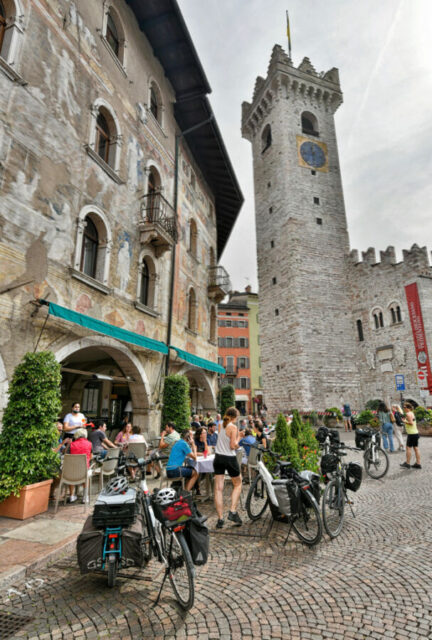
Trento has handsome, wide streets with marbled sidewalks. Each one stretches toward forested peaks and is lined by skinny, stony townhouses with big shutters and faded frescoes. Traffic-free lanes are lined with stone arcades and all of the hallmarks of an untouristy town: big chain stores with no interest in tourists, locals commuting by bike, and lots of people sitting at cafés sipping cappuccinos or bright-orange spritz cocktails. Trento’s cathedral feels like a castle, right down to the crenellations along its roofline, and it’s topped with an Austrian-style onion dome.
The list goes on and on. I stopped off at a few other new-to-me places that I also enjoyed. One was Bassano del Grappa, where I had a fine stroll and a coffee on the piazza before continuing on my way. I mention it only because I have a really cool photo of the place:
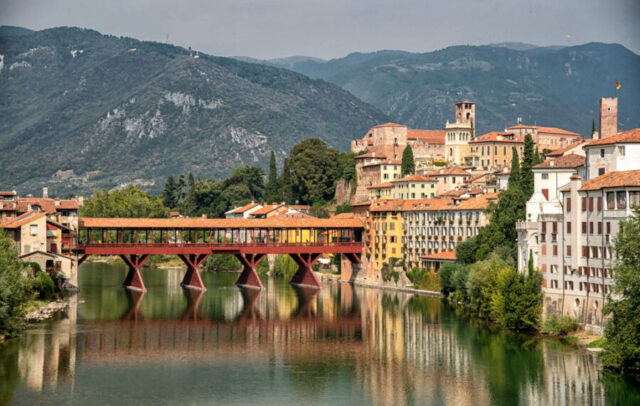
Of these four places — Modena, Lucca, Treviso, Trento — only one of them is covered in the Rick Steves guidebook, or appear on a Rick Steves tour itinerary: Lucca. (That also happens to be the most touristy — or, I guess, “least untoursty” — of the bunch.) After visiting each one, I wondered whether I should pitch Rick on adding them to the book. But that would make our overstuffed Italy book even more gigantic. Unless you want to start buying your guidebooks in volumes, we need to keep them selective.
More important, I don’t think a guidebook is necessary to enjoy these towns. None of them has a single “must-see” sight, or an artistic masterpiece that people travel miles for. Sure, if you’re bored, you can get a list of museums and churches from the TI. Or you can just relax, enjoy, toggle out of “tourist mode” and into “temporary European” mode…and melt into Italy.
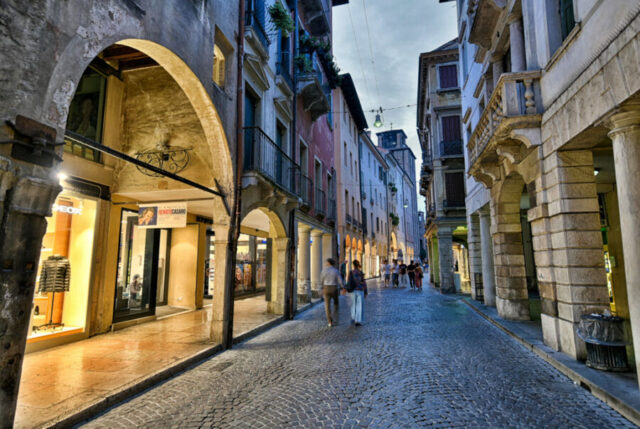
As you plan 2022 travels, consider doing just that — maybe not the entire trip, and not necessarily these four towns in particular. But at some point, mix in a day or two in a place that you never imagined you’d visit. A place your friends have never heard of. You may find those are the places you’ll never forget.
What about you? What are your favorite untouristy towns?
If you enjoy out-of-the-way places, pick up a copy of my new travel memoir, The Temporary European — packed with travel tales and insights. You can get it now in Kindle version, and it’ll be available everywhere on February 1.
How do we get the latest accurate information regarding Covid restrictions? We’re planning on traveling to Rome in March.
I would keep a close eye on the US embassy site in Italy, as things change very quickly. We were in Italy in September-October 2021 and felt very safe, but much has changed since then.
Lisa is correct. We are in Florence now and rules change frequently. Several times each day, we are asked for Green Passes, have to wear high-quality medical masks and remain outside to await turns in shops, museums, etc. I rather enjoy feeling I’m in the safest country, one that is doing everything to keep people safe. The only people I have observed arguing with the police (always a bed idea) are Americans. We will be here a total of three months and actually get great information from the NYT Coronavirus Newsletter. Sometimes closures are not announced, so stay flexible and relaxed.
Try Sherpa. We are traveling to Italy next week and all of the restrictions, requirements and forms are there for us to fill out.
Great read. We are spending a month in Bracciano for the month of September. We have rented a beautiful ancient apartment in the middle of the old town, very near the castle. Any suggestions would be greatly appreciated.
Awesome article Cameron!!!
That was a good article. We traveled north after leaving the Cinque Terra heading towards Austria and happened on a little town called Sabionetta! It had one hotel and a wonderful place to eat! We found the piazza where they were holding a mission festival. Bought some great wine and jellies from the nuns! A very non-touristy town. I think we were the only English speaking ones there!
Happy to see your photo and one line about Bassano! It is a beautiful area around the Ponte di Alpini and a stop at the grappa museum is fun. Shhh! Don’t tell anyone but… In nearby Possagno you can visit the church dedicated to hometown hero Antonio Canova who has art all over Italy and even a statue in The Louver. Picturesque Asolo and the prosecco wine region of Valdobbiadene round out the experience just north of Treviso. It is a wonderful area, but I hope it remains untouristy as well.
The Venato has many small treasures, including Bassano del Grappa, where Hemingway has a museum opened on the weekends only. Ferrara is also beautiful and Padova with the BO University of Padova with a very old Medical School and the unusual 4 architectural types of the St Anthony of Padova Cathedral. Also the Scrovenci
Thank you for this article. Treviso was our home base when we traveled to Italy. What a wonderful, friendly town. Incredible food that was reasonably priced. We traveled to and from Venice several times, took the train to Florence, and to Verona for an opera at the magnificent arena. The only tour we took was to the hill towns of the Veneto. The best of the best was Bassano del Grappa. Fascinating history, the wonderful Ponte Vecchio designed by Palladio, the grappa museum and shop, and the most wonderful shops, and town square. It’s absolutely lovely in the spring and summer with each building decked with flowers and the Dolomites as a back drop. The smaller towns are worth the effort!
Marcia… we just found out our cruise will not end in Venice as previously scheduled because of a new law regarding cruise ships. We will disembark in Treviso. Do you have any recommendations for places to stay for a couple of nights?
While author John Grisham is best known for his novels about lawyers, he also wrote the fun “Playing For Pizza.” A washed-up third-string NFL quarterback finds himself as the starting quarterback for a team in . . . Parma, Italy. Grisham’s descriptions of the food and culture of Emilia-Romagna are SO evocative and make me want to visit there someday!
That was a fun read!
Good read.
Cameron- Si, si, si ! After two trips to Italy during fall 2021, including an afternoon in Lucca and a whole week in Bologna, couldn’t agree with you more. Bologna in particular was an incredible surprise. My adult daughter and I chose Bologna as our base specifically because of its central location in the Emilia-Romagna region (translated: food), and because it is a beautiful and varied city in its own right. Bologna’s historic center is big enough (roughly 1.5 miles across) to provide endless options for walking, shopping & dining for all budgets, dining, and a variety of under-appreciated sights, attractions and activities. Not to mention miles and miles of porticoes that have made the city a UNESCO World Heritage site (see https://whc.unesco.org/en/list/1650). They also help when it rains. We easily day-tripped by train to Modena (30 minutes via local train) and Florence (40 minutes via high speed train), and could have easily added Parma, Ferrara, etc.). As sure as Tagliatelle Bolognese is delicious, and visiting a different cafe and gelateria every day is a worthy task, Bologna and surrounding towns are indeed worth a few pages in Rick’s guidebooks.
Totally agree with your comments – only thing I would disagree with is your suggestion to included Bologna and surrounding towns in R.S.’s guidebooks. It is one area of Italy that is very enjoyable due to being “non-touristic”.
Totally agree with Bob’s comments – only thing I would disagree with is your suggestion to included Bologna and surrounding towns in R.S.’s guidebooks. It is one area of Italy that is very enjoyable due to being “non-touristic”.
Bob – love to hear that you had a great week in Bologna recently! I am taking my 2 college aged sons there next month. We will be there 4 nights before heading to Rome. In addition to the food, there is great interest in the automotive industry and history there. We have a tour booked at the Pagani factory and will also visit Ferrari museum. Any tips for day trips, restaurants, etc would be welcomed!
I’m about to move to the Roero region, southeast of Torino, and have traveled fairly widely in Italy. I always urge Americans to see what they “should,” and then to venture outside the big three.
If you happen through Bassano del Grappa again, there’s an interesting museum celebrating the Alpini (the Alpine soldiers) next to the covered bridge.
Bassano del Grappa is also home to the Poli Grappa Museum. From there I also enjoy taking day trips to Asolo and Asiago a couple of more non-touristy places especially Asolo. And a short ride to Marostica is also recommended. I have unfortunately only been there in odd numbered years so I have never gotten to witness the human chess game in the main piazza. https://upload.wikimedia.org/wikipedia/commons/3/3f/Marostica6.JPG
Awesome article and so true. There are many “under the radar” locations throughout Italy that we hope to explore. A little surprised at the comment of having difficulties finding high quality meals in Florence and Venice. My wife and I were in both cities as recent as November 2021 and had two of the best meals of our life in Venice (Veno Vero and Trattoria Alla Scalia). Also went back twice to our favorite restaurant in Florence (Rosso Crudo) which seems never to be busy. As Rick has always promoted, we get to know the locals and find our best recommendations from just talking to them. And sometimes we get lucky and stumble upon (off the beaten path of course) what becomes one of our favorites not only because of the delicious food, but also the atmosphere and staff. We seriously love Italy like our second home and stay in touch with friends we have made through our travels. To all of the Rick Steves staff, writers, guides, and all those involved in producing the fantastic content and for keeping our dreams alive…THANK YOU!
I lived and worked in Rome in 1978-1979
I knew Rome like the back of my hand. I returned in 2019 to find it like a
Turkish ” bazaar” . No more small ” alimentari” the monument of Victorio Emanuelle looked like a beehive. I couldn’t see the monument from the street and on the streets around and inside was full of card readers card tricks. After 3 days in the city I figured I better go to Venice.
It was February so It wasn’t loaded with busful of tourists. 1 thing for sure foreigner regardless where they from they order ” pizza”. And I order ” bisteca Romana or exelent seafood in Vernazza”
We loved Vincenza – no tourists, but where Palladian lived and worked, and every building and cathedral glows with his style. An easy train ride from our favorite ‘base camp’ Verona. Mantua, Moderns, Padua, Vincenza, and a foray into the alps to Bolzano. Vincenza is worth a day, the others could be several days.
I have been to all of these towns, and your assessment is spot on…Ferrara BTW has the oldest wine bar in Italy, make it a stopping point the next time.
I discovered Ferrara about 5 years ago when I needed to choose a place on the map to stop the night before going to Venice. Fell in love with it and love thinking about the other off the beaten path towns you mention and likely so many more.
Hard to believe UNESCO world heritage sites could possibly be “under the radar.” They are all fantastic, however.
Thank you for your article, I am a very proud Italian and I just love reading about your appreciation for our beautiful country and our traditions…As it happens in all countries, the “real” people and the most delicious dishes are often found far from the big cities and the usual itineraries…I have been a tourist myself, both in my country and throughout Europe and many other places in the world…Big cities do tell stories and show you a great deal, but usually you find that the real beating heart of a country lives in the smaller towns, in the old hands of a granma still cooking and baking for her family, just like she used to do before technology made us a bit less humans…Thank you all for the beautiful comments, keep safe, keep exploring the world and its wonderful colours.
Love Lucca! Our hope is to spend an entire month there at some point in the future to really appreciate daily life in Italy. Best memories of our two days there…the young man at the gelato shop who appreciated our attempts at Italian, so he took us in the “back” to show us what he was making and give us samples; the bakery where we bought the best focaccia served by guy who roared with laughter when we told him he looked like Nicholas Cage; and the crowd that gathered on the street, in the rain, to ooh and aah as a truck attempted to make a turn on one of the very narrow streets. It still makes me smile.
If one has any interest in historic Italian automobiles, Basano del Grappa has the lovely Museo dell’automobile Bonfanti-VIMAR; Modena has the lovely museum devoted to Stanguellini who built beautiful winning race cars from common FIATs. Of course not far from Modena is Maranello, home of Ferrari but head out of town in the opposite direction and one can visit Lamborghini.
Go to Bologna, the town with the oldest university in the western world. Medieval towers, great food, and (sorry to say) even shops where you can buy distinctly local clothing. When I went there a few years ago, before a hiking trip through Tuscany, Rick’s guide book said, “Don’t go here; go to Ravenna.” WRONG. Where else do you get authentic spaghetti Bolognese? Slow down, and enjoy the town.
Lucca was a favourite of ours. I could go back any day and bike or wander across the city walls.
Your stories of un-touristy restaurants reminded me of our time in Olcio just outside of Como. Our friends made a happy mistake and booked us in a B&B in Olcio. We arrived in the evening and the B&B made us a reservation at some local restaurant. Ridiculously good unforgettable multi course home style authentic Italian meal fo 15 euros. We loved it so much we went back the next night. We were the only tourists there with a couple of tables of locals. One of the top meals of our lives and as you say, the unknown parts of Italy are almost always the best.
Very timely as we will be in Venice for four days in April between our RS Sicily and Rome tours. I can see a change in plans on the horizon. Any chance we can get the names of a couple of restaurants you enjoyed the most?
PS: love your new book, The Temporary European!
In whatever city you’re visiting just wander down the narrow, quieter side streets and look for the small cafes & restaurants with only a few tables outsides. The places with menus only, or mainly, in Italian and avoid places with menus that include picture of food. These are the places where the locals eat. You cannot go wrong.
I disagree with the suggestion that one cannot find a good meal in Venice or Florence. Some of the best meals I’ve had in Italy were in those cities. For food lovers I suggest looking into a cooking class. My friend and I signed up for one that took us shopping for our ingredients at the local markets then spending the rest of the day learning, cooking, making new friends and eating fabulous food with wine pairings. One of my favorite memories from Eataly.
Thank you for the article. I agree with everything. Sarteano is a good place from which to see Tuscany with day trips. It is such a big help to go with Italian speakers to the smaller towns. The Cinque Terra, Florence, Venice, and Rome have changed so much since the 80’s. My Italian brother-in-law says to go in the winter to miss the tourists.
We spent a week in San Pietro en Cariano which is about 30 minutes outside of Verona. We had a couple of the best meals of our lives there. There are also wonderful wineries making Amarone and Valpolicello. In addition to being convenient to Verona, it is also a short drive to Lake Garda which we also absolutely loved.
My favorite less-visited city was Salerno. It’s at the bottom of the Sorrentine Peninsula on the coast. (It was much less touristy than Sorrento.) We went in mid-November 10 years, to see Paestum. The Christmas lights were up, and as we stayed over the weekend many people came in the evening to enjoy the lights and Christmas shopping. There are buses to the Amalfi coast from Salerno, but we didn’t have enough time.
Downloaded your kindle ebook… Can’t wait to read it!
Hi Cameron. This is Gary, the “gentleman from Atlanta who lives part-time on Lake Como” that you mentioned in this blog. I really enjoyed the short chat we had in Treviso back in September 2021, maybe if we meet up again some day, we’ll have time to stop for an espresso or a Aperol spritz. I enjoyed reading your take on Trento and Modena and they are on my list of out of the way towns to visit in the near future. My plan is to return to Italy March 15 -May 18. Happy travels to you!
Gary! So great that you found this post. I really enjoyed bumping into you and having a chat. Hopefully we’ll cross paths again someday. Happy Travels!
My paternal grandparents emigrated from Lucca in 1913. My wife and I had the great fortune to go back and visit Lucca 100 years later, in 2013. We spent several days there walking the streets and enjoying everyday life, imagining what it must have been like for them and knowing that Lucca probably hadn’t changed much since they were there. We also took a train to my grandfather’s home town of Castelnuovo Di Garfagnana and spent two days there. Thanks to the incredible kind and generous hosts at the TI we were able to locate old commune records listing his parents and siblings and also hiked to a hillside that overlooks the valley where he was raised. This entire experience was so richly rewarding and emotional. We had also visited the “usual” tourist sites on a wonderful Rick Steves Heart of Italy tour prior to this side trip and as spectacular the tour was, nothing could beat our time spent in the Lucca Province and reconnecting with my paternal roots. Thanks for highlighting my family’s special part of northern Italy! My next trip needs to be to Pulia to connect with my mother’s family roots.
My family is from a small town in Calabria called San Vito Sull Ionio. It is a small well kept town and is near the ionio Sea beach area called Soverato! Love going to Italy and we are raking our family there this summer all 11 of us. We had planned this trip in 2020 to celebrate our 50th Anniversary! We are going to Venice, a Tenuta in Tuscany, then on to Rome.My children leave and we continue our trip down to the hometown to visit family. I have your books and love them!
We loved this village in Umbria… nice wine and lots of related Agritourism within shouting distance of Assisi.
This village, Torre del Colle, is a medieval castle recently renovated with all the needs of tourists: a beautiful locale, close to other tourist areas, hostel, B&B, and restaurant(s) along with outdoor activities. We did not stay here, but wish we had.
The first time we visited Italy – with our green Rick Steves Guidebook – everywhere we went in Siena and the Cinque Terre we saw the green book sticking out of someone’s backpack. This was back in the 90s, and both those places were very ‘untouristy’ at the time. I hate to say this, but inclusion in the green book makes the place a destination for thousands of tourists.
So we love you guys – but you don’t have to include every lovely Italian town in the guidebook. ;^)
Why don’t you or Rick offer a tour to these lesser- known places not just as side triip suggestions?
We Love Italy and have been there several times, inspired by Rick Steves to enjoy major sites, as well as to move on to back door places. From Rick’s back doors, we have found our own in this amazing country. Of towns described in this great article, we have only visited Lucca, though we’ve been to Verona and the Dolomites on one trip. We love to ride bikes on the Renaissance walls of Lucca right after checking in to our B&B. We’ve always wondered about the mountains we saw from the northern part of the wall. In 2014, we decided to do a Northern Tuscany trip. Wonderful! We picked up a car at the Florence airport and drove a southern route to Lucca, looping to the Medici Villa dei Poggio a Caiano, one of 12 villas the Medici owned. Only three other visitors all afternoon! We got over jetlag in Lucca with art, music, and food for a few days. Then drove through the Garfagnana to our base in Barga, where we stayed in a small villa across the valley with a view of the duomo and its huge trees against a backdrop of the Apuane Alps. We walked along an ancient cobbled road into Barga for dinners. We did a day trip to Fortezza delle Verrucole, which guarded the pass from France to Italy in the middle ages, and other drives to the Grotta del Vento (Cave of the Wind), and Isola Santa (a small village partly submerged by a modern reservoir with an interesting church and a lovely stream with white marble chips instead of gravel on the shores). One one mountain drive, we emerged from a reeally loong tunnel to a stunning view of sky, the Ligurian Sea, and marble mountains dotted with quarries. On to Pietrasanta, our coastal base where we saw Botero statues and frescoes. We took a day trip to tour Carrara quarries, eat lardo (amazingly good), and do an abbreviated Cinque Terre hike (Corniglia to Monterosso al Mare). We stopped for one night in Pistoia (silver altar at duomo, wonderful museum in city hall, place where the pistol was invented!) on the way to Florence for 5 days. We always stay in a RS-suggested place in the centro of Florence and enjoy strolling from dinner to our B&B after most tourists have left. We make reservations to avoid frustration. I recommend Jane Fortune’s To Florence Con Amore for backstreet sites such as Last Supper frescoes in refectories around the city. I have a severe and chronic case of Stendhal Syndrome!
We’ve been fortunate to have been in Italy seven times. Last year we finally
made it to Lucca and stayed for three days. We loved it. The wall, the towers,
the walks inside the city, churches, museums, beautiful homes, and the food as
well. Maybe my personal favorite part was walking all the way around the top
of the wall which is amazingly tall and wide with terrific views into and out of the
city. It will take you a while but the views are extraordinary. Go. It’s a terrific city.
Rovereto, near Trento, is magnificent! On our visits there we saw no tour groups. It‘s a marvelous place for wandering. We love the Museum of Modern and Contemporary Art and the Casa D‘Arte Futurista Depero, which made us aficionados of this terrific, prolific artist with his graphic design, textiles, puppets and more. There are a botanical garden, parks, turrets, hills, small producers, castles, vistas, hiking opportunities, vineyards, and a weekly market. Highly recommended!
In the north of Italy, my favorite ‘not in Rick’s book’ place is Bergamo. I was lucky enough to spend two weeks there about ten years ago, and loved the architecture, the the neighborhoods, the food and the wine… And in the south, my favorite is Caserta, with its stunning royal palace, and its older incarnation, Casertavecchia, full of twisty medieval lanes.
I completely agree with your comments to visit the less touristy locations, too. I always add a couple to an itinerary. In Italy, we’ve been to Moena in the Dolomites – charming, Grosseto – had a fun unexpected night local music festival and an amazing dinner, Lucca, Arezzo – attended their jousting festival and my B&B host recommended a fantastic tiny restaurant, Stresa – lovely and stayed last time at a boutique hotel on Isola Bella, Parma – memorable meal at La Forchetta & my favorite Italian cathedral. 2020 & 2021 cancelled itineraries are happening this year, so Bergamo, Mantova, Modena (nice you mentioned it, too!), Ferrara and Spello are coming up in a few months!
On the flip side, I really feel sorry for Cinque Terre, and to an extent, what’s happened to Venice. We enjoyed the leisurely hiking & boating and general relaxing ambiance of Cinque Terre many years ago. There’s a delicate balance between tourist dollars & local living.
u3iauds11
Thanks for this article, Cameron. It makes me want to extend our September tour in Tuscany, which ends in Lucca. We’ve been there before and love it. Maybe we’ll venture out a little from Lucca….
I want to mention Cremona, which is a train ride (1 hour) from Milan. Yes, it’s a bit out of the way but there is a violin museum there that is fantastic. Also, the squares have pianos and the students walk up and play at will. Great experience, off the beaten path.
Probably not considered “untouristy“ but not your typical place people visit when going to Italy for the first time, we spent two days in Orvieto and were totally charmed! We traveled with friends but they stayed in Rome and then we all met up in Florence. We still think about Orvieto and going back, taking our friends this time so they can experience the charming little hilltop town as well:)
My daughter will be studying in Rome for 6 weeks. We plan on visiting and making a trip to Modena. Does anyone have any recommendations for accommodations? We will be ctaking the train in from Venice. I have no idea where to begin. Thank you for your time.